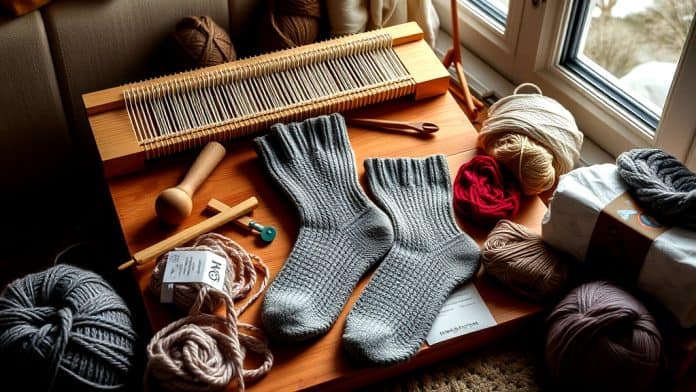Free Loom Knitting Sock Patterns
Diving into the cozy and creative universe of loom knitting has never been more inviting, especially when it’s all about socks that hug your feet like a warm cup of tea on a chilly February morning. If you’ve been curious about how to make loom knit socks, you’re in the right place. From selecting the perfect sock loom to tackling those knit sock challenges head-on, we’ve got your back.
Loom knitting for beginners can seem like a maze, but fear not. With simple tools like a basic toe-up socks pattern, a couple of pegs, and some yarn, you’ll weave magic in no time. We’ll even demystify the short row and stitch pattern, making you wish every month was February.
Whether you’ve got an oval sock loom gathering dust or you’re plotting your next visit to the yarn store, this guide promises to turn your looming curiosity into a full-blown passion. So, grab your loom knit essentials, and let’s cast on a sock leg adventure that even your grandma would envy.
Key Takeaways
- Selecting the right loom size, such as an oval sock loom, is critical for sock knitting projects.
- Basic tools like yarn, tapestry needles, and a couple of pegs are must-haves for starting.
- Grasp the concept of short row and stitch pattern to add texture and design to your socks.
- Overcome common issues like loose stitches by adjusting tension for a snug, custom fit.
- Try beginner-friendly basic toe-up socks patterns to kickstart your loom knitting adventure.
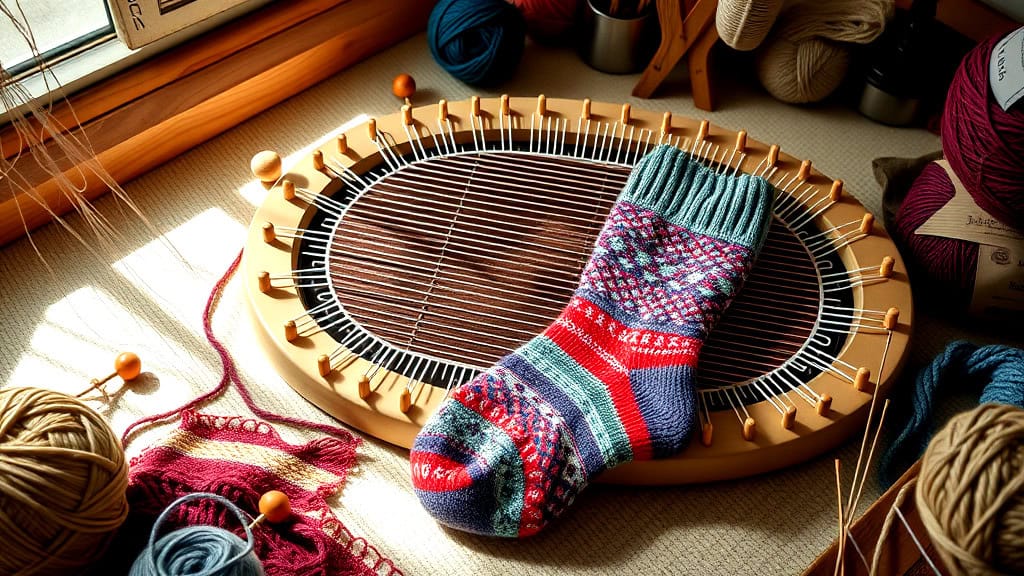
Choosing the Right Loom for Socks
When picking the proper loom for crafting socks, it’s a balancing act between the loom’s peg count and its adaptability to varying yarn thickness. For those delving into free loom knitting sock patterns, the selection process is pivotal. An oval sock loom shines for its versatility, especially for beginners aiming to master knit basic toe-up socks.
Table: Loom Options for Sock Knitting
| Loom Type | Peg Count | Best For |
|---|---|---|
| Oval Sock Loom | 48 Pegs | Basic Socks |
| Adjustable Multi-Knit | 60 Pegs | Larger Socks |
| Flexee Loom Skinny | 72 Pegs | Detailed Patterns |
| Classic Round Loom | 24 Pegs | Quick Projects |
| Long Loom | Variable | Custom Sizes |
- Choose a loom with enough pegs.
- Opt for adjustable looms for size flexibility.
- Prioritize looms with comfortable grip.
- Include a loom hook and tapestry needle in your toolkit.
- Start with an oval sock loom for ease.
- Experiment with stitch patterns like ribbing.
- Practice short row techniques for shaping.
Essential Tools and Materials for Success
To achieve success in loom knitting socks, certain tools and materials are indispensable. A prime choice for enthusiasts is the Adjustable Multi-Knit Loom for its versatility in handling sock patterns. For those chilly days in February, crafting a cozy pair becomes a delightful project. Selecting the right yarn, such as a blend of wool and nylon, ensures durability and comfort. Yarn choice is critical, especially when considering the sock leg and foot’s wear and tear.
Embarking on loom knit basic toe-up socks introduces beginners to foundational skills. Utilizing pegs effectively allows for a snug fit and intricate designs. February might be the perfect month to experiment with these skills, given its cozy indoor weather appeal. A detailed stitch pattern can transform a simple project into a work of art. For more intricate designs, the Flexee Loom Skinny emerges as a top tool, allowing for detailed work on smaller pegs. Etsy showcases a range of yarns ideal for these projects.
Understanding Sock Loom Gauges
Grasping the concept of gauges in sock loom knitting is akin to unlocking a secret level in a video game. Each gauge size, from small to large, influences the texture and fit of your loom knit socks. Think of it as choosing the right character for a mission. For those cozy February evenings, nothing beats slipping into a pair customized just for you.
Here’s a quick guide:
| Gauge Size | Peg Count | Ideal for |
|---|---|---|
| Small | 40 | Fine yarns |
| Medium | 31 | Wool blends |
| Large | 24 | Bulky yarn |
- Select a gauge matching your yarn thickness.
- Count pegs to fit your foot size.
- February is a prime time to start with medium gauge.
- Stitch patterns add flair.
- Short rows create shape.
- Don’t forget the sock leg.
- Experiment with colors.
Remember, the choice of gauge can make or break your knit basic toe-up socks. So, choose wisely and let your creativity flow with free loom knitting sock patterns.
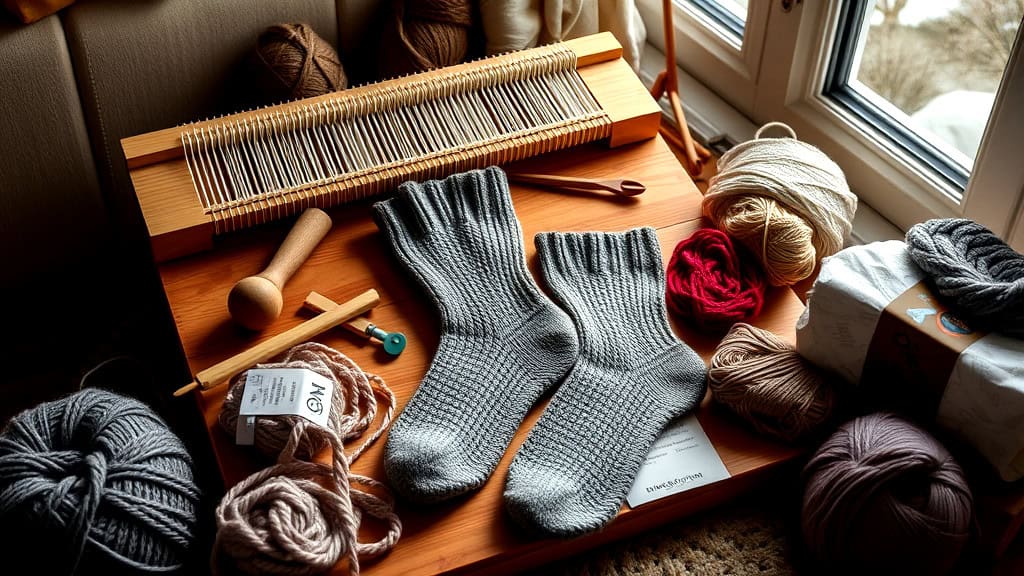
Mastering Basic Toe-Up Sock Techniques
To become skilled at crafting toe-up socks, it’s critical to grasp the short row technique, which allows the toe to curve naturally. A core skill for loom knit basic enthusiasts, this method ensures a snug, comfortable fit. Here’s a quick guide to get you started:
- Select your pegs according to sock size and yarn thickness.
- Begin with the toe section using a wrap-and-turn to shape it.
- Increase stitches gradually to expand for the foot width.
- Work on the sock leg, maintaining even tension throughout.
- Apply a stitch pattern to add texture or color variations.
- For durability, choose a yarn blend resilient to wear and tear.
- Mark February as the perfect time to practice, creating gifts or personal items.
Remember, practice makes perfect. With each loom knit socks project, you’ll find your rhythm and style.
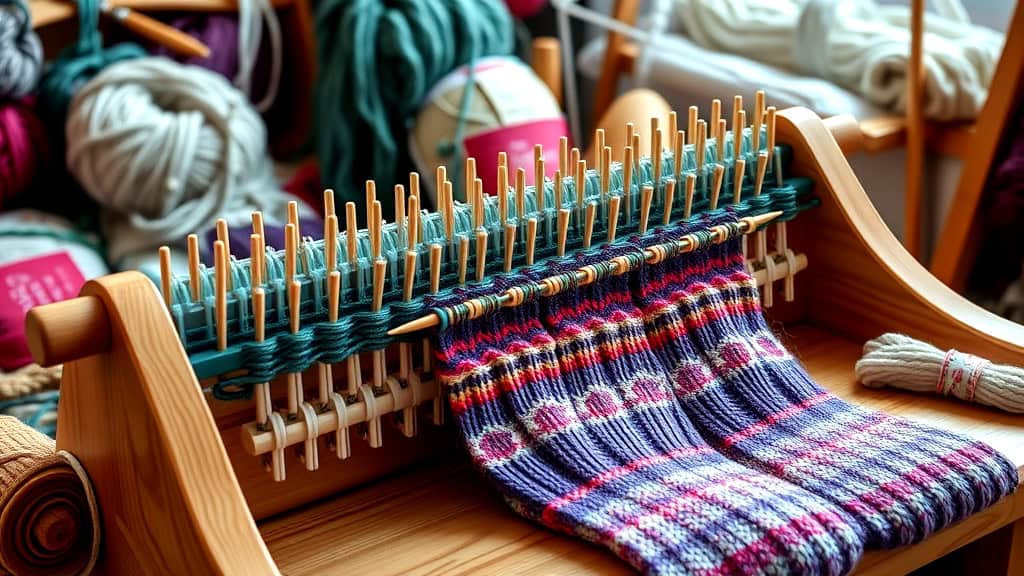
Exploring Various Stitch Patterns
Diving into the myriad of stitch patterns unlocks a new level of creativity for those free loom knitting sock patterns. Each pattern offers its own charm, whether it’s the cozy feel of a ribbed cuff or the intricate beauty of lace stitches.
For instance, horizontal ribbing isn’t just about aesthetics; it provides elasticity, making your socks more comfortable and fitting. Plus, who doesn’t love the classic look of K2, P2 ribbing on the sock leg? It’s a simple technique that yields professional-looking results.
And let’s not forget the importance of pegs. The right number can make or break your pattern. With February around the corner, it’s a great time to experiment with these patterns.
| Pattern Type | Pegs Required | Ideal Yarn Type | Completion Time |
|---|---|---|---|
| Horizontal Ribbing | 48 | Worsted | 5 hours |
| K2, P2 Ribbing | 48 | Merino Wool | 6 hours |
| Lace Stitches | 52 | Lightweight Yarn | 8 hours |
| Cable Knit | 50 | Wool Blend | 7 hours |
| Short Row Heel | 48 | Cotton Blend | 3 hours |
Remember, every stitch pattern adds its own flair to your creations.
Common Knit Sock Challenges Solved
Addressing typical hurdles in knitting socks on a loom, we’re here to untangle the most common snags you might encounter. With a focus on free loom knitting sock patterns, let’s jump straight into it.
- Ensuring a snug fit can be tricky. Measure your foot accurately and consult the pattern’s suggested foot length.
- Loose stitches can ruin the look. Pull each loop a bit tighter as you work around the pegs.
- Picking the right yarn is critical. Opt for wool blends during colder months like February, and lighter yarns for summer.
- Master the short row technique for heels. It’s a game-changer for a comfortable fit.
- The sock leg length can be a personal preference. Experiment with different lengths to find your perfect style.
- Don’t forget the importance of pegs. The number of pegs directly affects the size of your socks.
- If you’re starting out, make loom knit basic toe-up socks your go-to project. They’re simpler and offer a great base for learning.
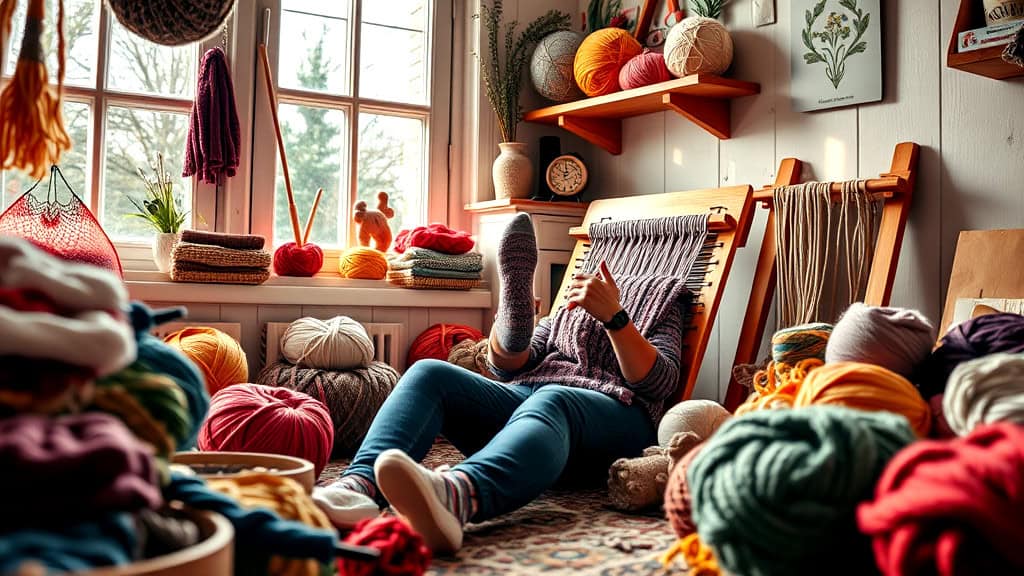
Step-by-Step Guide to Striped Footies
To create striped footies, beginning with selecting a colorful range of yarns is a must. February is an ideal time to pick warm hues for a cozy feel. Consider the peg count on your loom for size adjustments, as it’s pivotal for a snug fit. For a seamless pattern change, use the short row method, allowing for smooth color transitions without creating bulk.
| Step | Task | Peg Count | Month |
|---|---|---|---|
| 1 | Choose yarn colors | – | February |
| 2 | Cast on with color A | 24 pegs | – |
| 3 | Knit 10 rows | 24 pegs | – |
| 4 | Switch to color B | 24 pegs | – |
| 5 | Knit 10 rows | 24 pegs | – |
This guide ensures that by following simple steps, you can create custom, colorful footies that stand out. Remember, adjusting the pegs and practicing the short row technique are your allies in achieving the perfect fit and pattern.
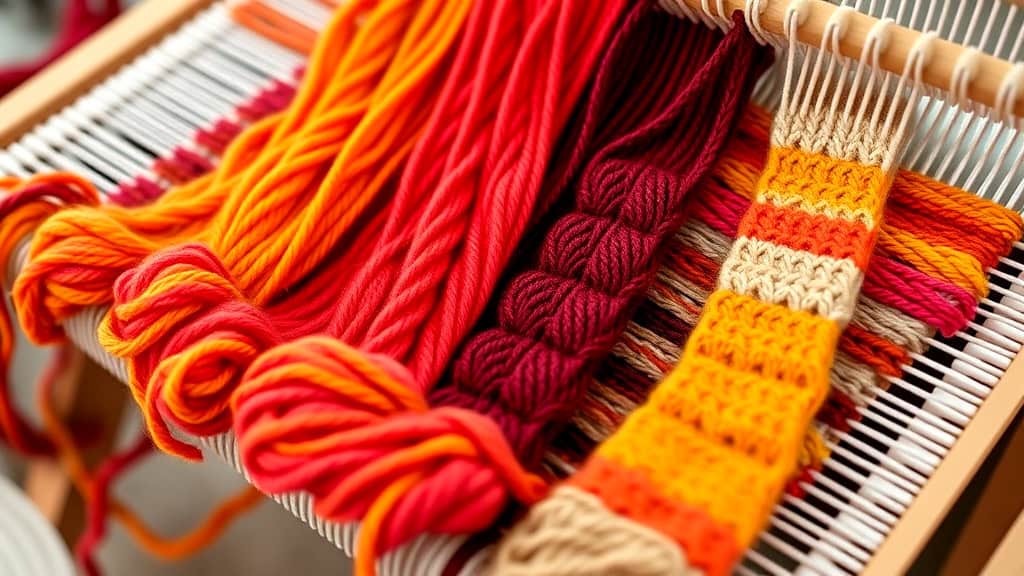
Top 3 Toe-Up Sock Patterns for Beginners
For those new to the loom knit socks scene, finding straightforward patterns is like striking gold. Let’s highlight three stellar free loom knitting sock patterns perfect for beginners. Each one promises simplicity and style, making them ideal projects for dipping your toes into the warm waters of loom knitting.
The Sunshine Socks pattern brightens any dreary day, requiring just basic stitches and a cheerful disposition. With a focus on the short row technique, it introduces newcomers to shaping socks without overwhelming them. Peg adjustment is minimal, making it a breeze.
For February enthusiasts, the Heartbeat Socks offer a rhythmic stitch pattern that captures the month’s spirit. You’ll use exactly two pegs more than usual, adding a fun challenge without complication.
Striped Footies bring a playful twist to your sock drawer, using color changes to add flair. This pattern keeps you on your toes, figuratively speaking, with an easy peg adjustment for a snug fit. Perfect for those looking to add a splash of fun to their basic toe-up socks.
Conclusion
Loom knitting socks is a game changer. It turns “I can’t knit” into “look at my socks!” This guide makes it easy. From picking your loom to finishing your very own cozy socks, we’ve got you covered.
Choosing the right loom matters. Adjustable or Flexee? It depends on your sock dreams. And yarn? It’s like picking a team – wool for warmth, nylon for stretch. Together, they’re unbeatable. Keep a tapestry needle and loom hook handy. You’ll need them.
Gauge sounds technical, but it’s just about how your sock fits. Think of it as the sock’s DNA. Toe-up techniques might sound like a circus act, but it’s really just knitting magic. With a few flips and turns, you’ve got a sock starting to shape up.
Patterns can jazz up your socks. Horizontal ribbing or K2, P2? It’s your canvas. Loose stitches or fit issues? There’s always a trick up the sleeve. For striped footies, it’s all about color dance. Follow the steps, and you’ll have socks that make people say, “You made those?”
For beginners, we recommend starting simple. Sunshine Socks or Striped Footies are like the ABCs of loom knitting socks. They’re free and friendly for newbies.
Knitting socks on a loom is like unlocking a secret skill. It’s not just about warm feet; it’s about crafting something personal, stitch by stitch. Whether you’re a beginner or looking to polish your skills, these patterns and tips set you up for success. So, grab your loom, pick a pattern, and start your sock knitting adventure. Who knew loops and yarn could lead to such a cozy outcome? Happy knitting!
FAQ
- What is loom knitting and why should I try it?
Loom knitting is like magic with yarn! It’s a fun way to knit socks without needles. Super for beginners since it’s easier to handle. You can make cozy, custom socks. - How do I pick the right loom for my socks?
Think of choosing a loom like picking the right shoes. You need one that fits your project. For socks, small looms with adjustable sizes work best. Check out the Adjustable Multi-Knit Loom or the Flexee Loom Skinny. They’re awesome starting points. - What materials will I need to start?
You’ll need a superhero toolkit! Grab some yarn—wool and nylon blends are tough and comfy. Don’t forget a loom hook and tapestry needles. They’re your trusty sidekicks. - Can you explain loom gauges?
Gauges are like the secret sauce to great fitting socks. They determine how tight or loose your knit will be. For socks, smaller gauges create snug, warm hugs for your feet. It’s all about that cozy fit! - What if my socks don’t fit right or look weird?
No worries, every superhero has a learning curve! If your socks are too big or small, try adjusting your loom’s tension. Loose stitches? Tighten up your yarn wrapping. Practice makes perfect. Keep at it, and you’ll be a sock wizard in no time!

